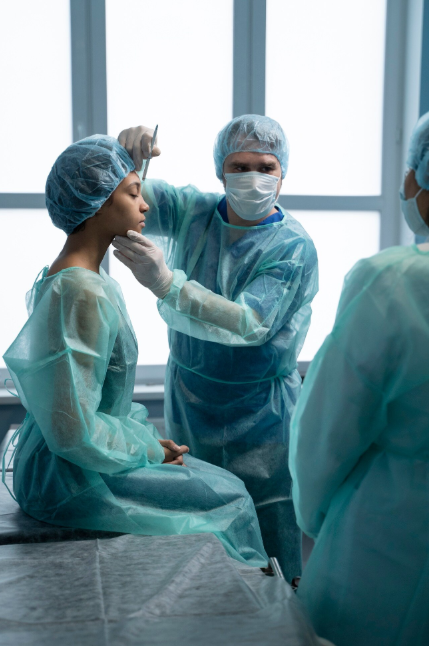Treatment Overview
Middle Eastern ethnic rhinoplasty is a specialized surgical procedure designed to address the distinct nasal features often found in patients of Middle Eastern descent. Common characteristics include a high nasal bridge, dorsal hump, drooping or over-projected tip, thicker skin, and a wide or downward-pointing nasal base.
The goal of Middle Eastern rhinoplasty is to refine nasal aesthetics while maintaining cultural identity and facial balance. In Korea, surgeons are internationally recognized for their artistry, structural techniques, and ability to achieve natural results that respect the patient’s ethnic heritage.
Purpose & Benefits
The main purpose of Middle Eastern rhinoplasty is to enhance nasal shape while preserving ethnic individuality. Benefits include:
- Reduction or smoothing of a prominent dorsal hump.
- Tip refinement for better projection and definition.
- Narrowing of wide nostrils or alar base.
- Correction of drooping or over-projected tips.
- Improvement of facial balance while respecting cultural features.
- Functional improvements for breathing issues (if combined with septoplasty).
Ideal Candidates
Middle Eastern ethnic rhinoplasty in Korea is ideal for individuals who:
- Are of Middle Eastern descent seeking nasal refinement.
- Have a dorsal hump, drooping tip, or wide nasal base.
- Desire subtle, natural results that preserve ethnic harmony.
- May require both aesthetic and functional correction.
- Are in good health with realistic expectations.
Possible Risks & Complications
Like all surgical procedures, risks may include:
- Temporary swelling and bruising.
- Over- or under-correction of nasal features.
- Breathing difficulties if internal support is insufficient.
- Scar tissue formation, particularly with thick skin.
- Asymmetry during healing.
- Rare need for revision surgery.
Surgical Techniques Used
Korean surgeons use advanced and highly customized techniques for Middle Eastern noses:
- Dorsal Hump Reduction: Smoothing or reshaping the bridge for a straighter profile.
- Tip Refinement: Cartilage grafting or suturing to create a more defined, natural-looking tip.
- Projection Control: Adjusting an over-projected or drooping tip for better balance.
- Alar Base Reduction: Subtle narrowing of wide nostrils while maintaining natural proportions.
- Septoplasty (if needed): Correcting deviations for improved breathing.
- Cartilage Grafting: Using septal, ear, or rib cartilage to strengthen nasal structure and maintain long-term stability.
Recovery & Aftercare
- Swelling & Bruising: Most visible in the first week, improving within 1–2 weeks.
- Splints & Stitches: External splints removed after 7–10 days; internal stitches often dissolve naturally.
- Downtime: Most patients resume normal activities in 10–14 days.
- Final Results: Initial refinement visible within 2–3 months; full healing and definition in 9–12 months.
- Aftercare in Korea: Clinics provide anti-swelling injections, scar prevention treatments, LED therapy, and concierge aftercare support for international patients.
Results & Longevity
Middle Eastern rhinoplasty in Korea offers natural, long-lasting outcomes. By focusing on cartilage support and structural techniques, results remain stable while enhancing facial harmony without erasing ethnic features. Patients achieve refinement and improved nasal function that lasts for years.
Treatment Process in Korea
1. Consultation
- 3D imaging and facial ratio analysis for tailored planning.
- Detailed discussion of aesthetic and functional goals.
2. Pre-Surgery Care
- Comprehensive health evaluation and nasal examination.
- Personalized surgical plan respecting Middle Eastern features.
3. Surgery
- Performed under general anesthesia or sedation.
- Duration: 2–4 hours, depending on complexity.
- Techniques customized to preserve ethnic harmony.
4. Immediate Post-Surgery Care
- Monitored recovery with protective nasal splint.
- Pain management and swelling-reduction therapies provided.
5. Follow-Up & Aftercare
- Regular check-ups with advanced aftercare support.
- International patients often receive translation, transport, and recovery services.
Why Korea?
- Refined Expertise: Korean surgeons excel at balancing cultural preservation with aesthetic refinement.
- Advanced Techniques: Structural grafting ensures stable, natural results.
- Natural Outcomes: Focus on enhancing—not erasing—ethnic identity.
- Medical Tourism Support: Korea provides comprehensive packages for international patients, including interpreters and aftercare.
Cost Range
The cost of Middle Eastern ethnic rhinoplasty in Korea depends on complexity and surgeon expertise.
- General Price Range: ₩7,000,000 – ₩15,000,000 KRW (approx. $5,600 – $12,000 USD).
- Basic Packages Include: Surgeon’s fee, anesthesia, surgery, and standard follow-ups.
- Premium Packages May Include:
- Rib cartilage grafting (if required)
- 3D imaging consultations
- Luxury recovery suites
- Anti-swelling therapies & scar care
- Interpreter and medical tourism concierge support
Popular Clinics
- Banobagi Plastic Surgery (Seoul): Famous for natural ethnic rhinoplasty outcomes.
- ID Hospital (Seoul): One of Korea’s largest cosmetic hospitals, serving global patients.
- JW Plastic Surgery Clinic: Known for structural grafting expertise and balanced results.
- View Plastic Surgery Clinic: Offers specialized services for foreign patients.
- MINE Plastic Surgery Clinic: Focuses on natural, long-term outcomes with advanced techniques.




